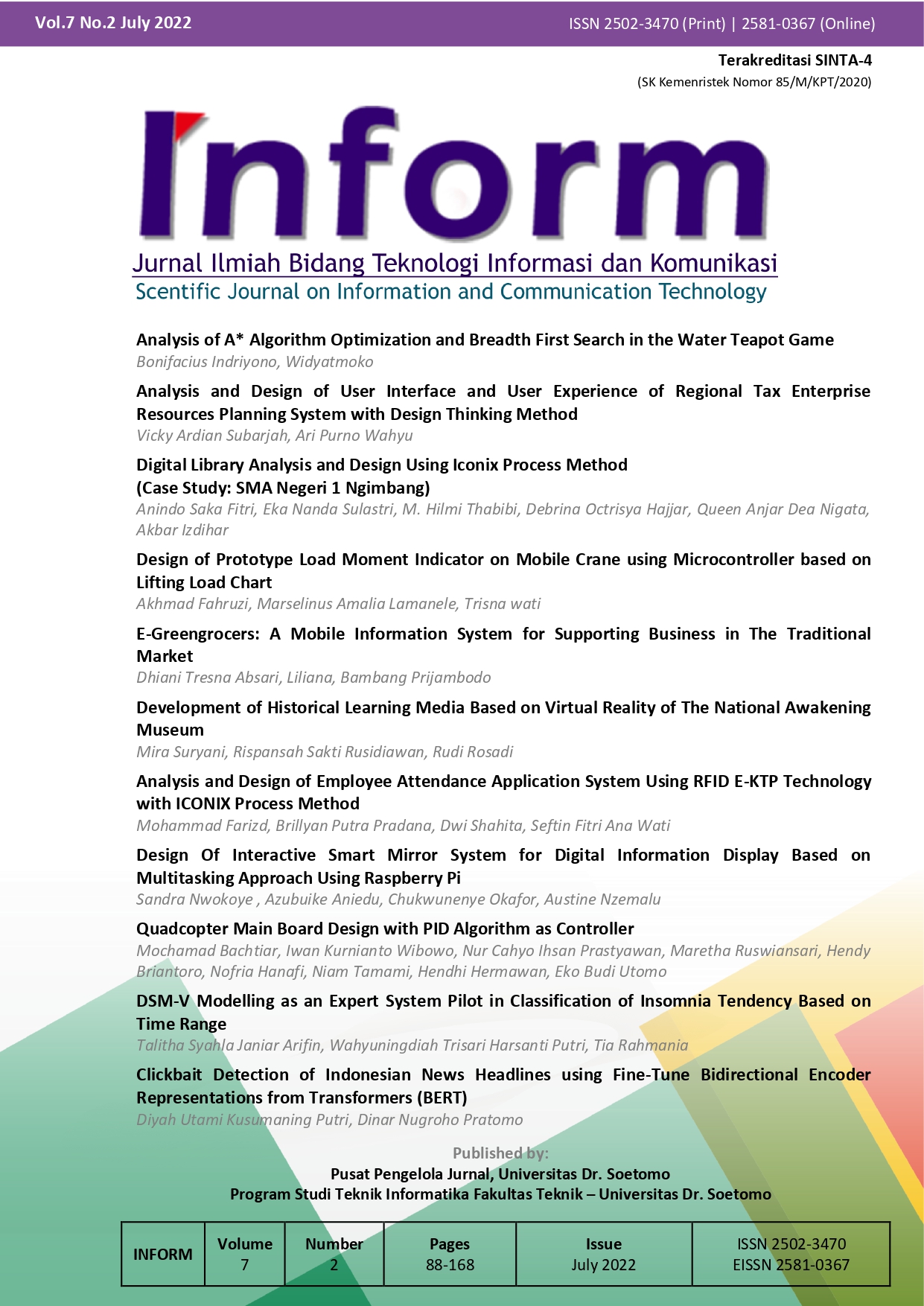Analysis and Design of User Interface and User Experience of Regional Tax Enterprise Resources Planning System with Design Thinking Method
 Abstract views: 1453
,
Abstract views: 1453
,
 PDF downloads: 1048
PDF downloads: 1048
Abstract
Regional Tax is one of the main sectors of independent income owned by each City or Regency to fund infrastructure development, education development, health services, and much more. The government agency that manages this regional tax is Badan Pendapatan Daerah, abbreviated as Bapenda. In particular, the West Bandung Bapenda has not implemented an online-based Regional Tax service system. This management system cannot be developed, and taxpayers have no independent account management. The appearance and user experience of the existing system has not matched the current design trends and the latest organizational structure. This greatly obstructs the services of Bapenda to taxpayers due to the lack of digital transparency. The system's flow is quite convoluted, thus affecting the quality and slow access to information. These limitations will be resolved through structured research using the Design Thinking and Usability Testing method for testing so that later it can be translated into an Enterprise Resources Planning system design with a good User Interface / User Experience. This method is structured following five phases: empathy, define, ideate, prototype, and test. The empathy phase aims to understand user problems, the define phase identifies and maps problems, the ideate phase aims to generate ideas, the prototype phase aims to implement the design based on the results of the previous steps, and the test phase aims to test the user. The final phase is the test phase and aims to test the user. The results obtained after applying this method follow user expectations.
References
. Morris, J. J. The impact of enterprise resource planning (ERP) systems on the effectiveness of internal controls over financial reporting. Journal of Information Systems, 25(1), 129–157, 2011. https://doi.org/10.2308/jis.2011.25.1.129
. Akrong, G. B., Shao, Y., & Owusu, E. Evaluation of organizational climate factors on tax administration enterprise resource planning (ERP) system. Heliyon, 8(6), e09642, 2022. https://doi.org/10.1016/j.heliyon.2022.e09642
. Eden, R., Sedera, D., & Tan, F. Sustaining the momentum: Archival analysis of Enterprise Resource Planning systems (2006-2012). Communications of the Association for Information Systems, 35, 39–82, 2014. https://doi.org/10.17705/1cais.03503
. Shirvanadi, E. C. Amikom Center Dengan Metode Design Thinking ( Studi Kasus : Amikom Center ). Amikom, vol.2, 2021. https://journal.uii.ac.id/AUTOMATA/article/view/19438/11541 [4]
. T. Brown and B. Katz. Change by Design J. Prod. Innov. Manag, 381-383, 2011 . https://doi.org/10.1111/j.1540-5885.2011.00806.x
. Peraturan Daerah Kabupaten Bandung Barat Nomor 12 Tahun 2016 Tentang Pajak Daerah. Standar Nasional Pendidikan. 22 Desember 2016. Lembaran Daerah Kabupaten Bandung Barat Tahun 2016 Nomor 12 Seri B. Bandung Barat. https://jdih.bandungbaratkab.go.id/get-download?source=peraturan&id_peraturan=171
. Kanchana, V., & Sri Ranjini, S. Investigation and study of vital factors in selection, implementation and satisfaction of ERP in small and medium scale industries. International Journal of Electrical and Computer Engineering, 8(2), 1150–1155, 2018. https://doi.org/10.11591/ijece.v8i2.pp1150-1155.
. Interaction Design Foundation, User Interface Design (2022). [Online]. Available: https://www.interaction-design.org/literature/topics/ui-design [Accessed: 11-05-2022].
. Yusaliano, M. R., Syahrina, A., & Kusumasari, T. F. User Interface Design of P2P Lending Mobile Application Using Design Thinking. ICITEE 2020 - Proceedings of the 12th International Conference on Information Technology and Electrical Engineering, 180–185, 2020. https://doi.org/10.1109/ICITEE49829.2020.9271780
. Wired. Figma Wants Designers to Collaborate Google-Docs Style (2017) [Online]. Available: https://www.wired.com/story/figma-updates/ [Accessed: 19-07-2022].
. Nasution, W. S. L., & Nusa, P. UI/UX Design Web-Based Learning Application Using Design Thinking Method. ARRUS Journal of Engineering and Technology, 1(1), 18–27, 2021. https://doi.org/10.35877/jetech532
. Wolniak, R. The Design Thinking method and its stages. Systemy Wspomagania w Inżynierii Produkcji: Support Systems in Production Engineering, Vol 6, Iss. 6, Vol. 6,(6), 247–255, 2017. http://yadda.icm.edu.pl/baztech/element/bwmeta1.element.baztech-81d700a1-e4ea-4257-87cf-d0b790873bc8
. Alfaridzi, M. D., & Yulianti, L. P. UI-UX design and analysis of local medicine and medication mobile-based apps using task-centered design process. 2020 International Conference on Information Technology Systems and Innovation, ICITSI 2020 - Proceedings, 443–450, 2020. https://doi.org/10.1109/ICITSI50517.2020.9264947
. Ilham, H., Wijayanto, B., & Rahayu, S. P. Analysis and Design of User Interface/User Experience With the Design Thinking Method in the Academic Information System of Jenderal Soedirman University. Jurnal Teknik Informatika (Jutif), 2(1), 17–26, 2021. https://doi.org/10.20884/1.jutif.2021.2.1.30
. Suzianti, A., & Arrafah, G. User interface redesign of dental clinic ERP system using design thinking: A case study. ACM International Conference Proceeding Series, 193–197, 2019. https://doi.org/10.1145/3364335.3364369
Copyright (c) 2022 Vicky Ardian Subarjah

This work is licensed under a Creative Commons Attribution-ShareAlike 4.0 International License.
Authors who publish with Inform: Jurnal Ilmiah Bidang Teknologi Informasi dan Komunikasi agree to the following terms:
-
Authors retain copyright and grant the journal right of first publication with the work simultaneously licensed under a Creative Commons Attribution License (CC BY-SA 4.0) that allows others to share the work with an acknowledgment of the work's authorship and initial publication in this journal.
-
Authors are able to enter into separate, additional contractual arrangements for the non-exclusive distribution of the journal's published version of the work (e.g., post it to an institutional repository or publish it in a book), with an acknowledgment of its initial publication in this journal.
-
Authors are permitted and encouraged to post their work online (e.g., in institutional repositories or on their website) prior to and during the submission process, as it can lead to productive exchanges, as well as earlier and greater citation of published work.













